- Home
- Mattresses
- King

Overview
King mattresses (a.k.a. Eastern Kings) measure 76 inches by 80 inches and are a top choice among couples. These mattresses have the same dimensions as two twin XLs pushed side-by-side, so they offer plenty of room for two adult sleepers. Kings don’t fit in every bedroom, though, and are best suited for master bedrooms and larger apartments. Browse our king size mattresses, starting at $1149.
- Price
- All
- $1001 - $1600
- $1601 - $2000
- $2000 - $4000
- Mattress type
- Packages
- Comfort
- Best for
- Height profile
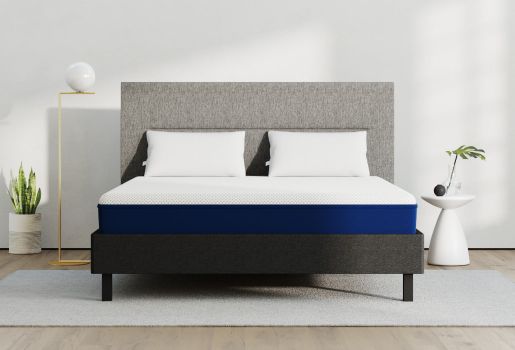
- Firm feel
- 2" of Bio-Pur®
- 8" of Bio-Core®
- Soft, breathable cover
- Sturdy edges

- Medium-firm feel
- 2" of Bio-Pur®
- 3" of HIVE®
- 7" of Bio-Core®
- Ultra-breathable comfort
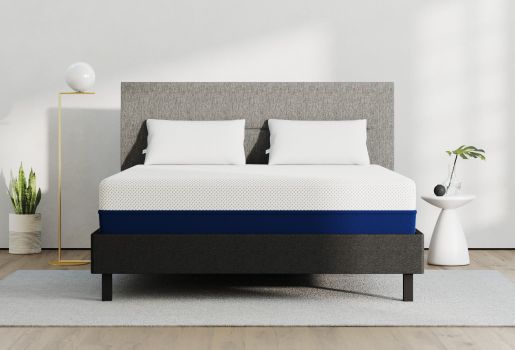
- Medium feel
- 3" of Bio-Pur®
- 2" of HIVE®
- 7" of Bio-Core®
- Blends comfort and support
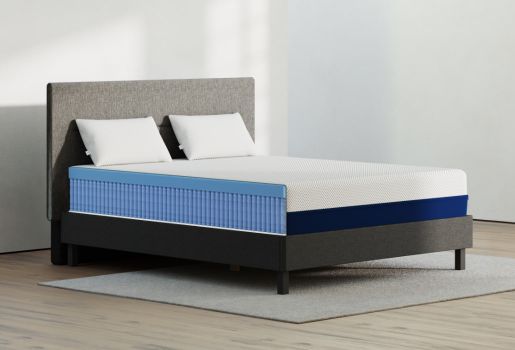
- Medium feel with a bounce
- 3" of Bio-Pur®
- 8" of Zoned Pocketed Coils
- 1" of Durable Base Foam
- Ultra-soft cover

- Offers cloud-like comfort
- 4" of Bio-Pur
- 1" of HIVE
- 7" of Bio-Core
- Softness without sinkage
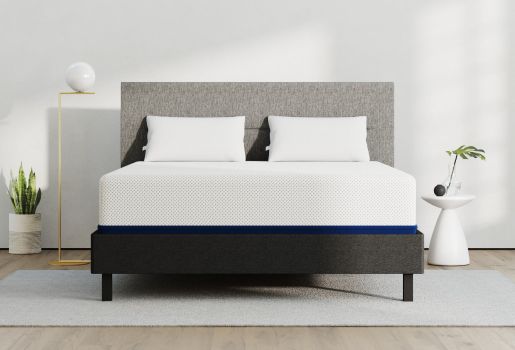
- Soft feel
- 3" of Bio-Pur®
- 2" of Active Flex
- 2" of HIVE®
- 7" of Bio-Core®
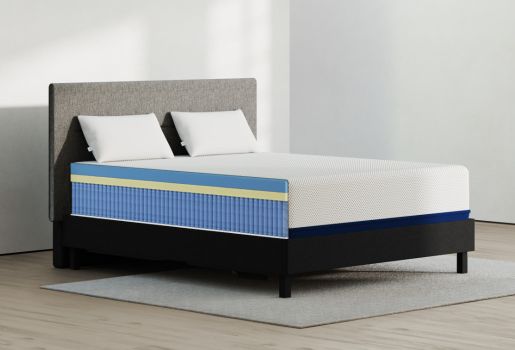
- Blends cushion and bounce
- 3" of Bio-Pur®
- 2" of Bouncy Active Flex
- 8" of Zoned Pocketed Coils
- 1" of Durable Base Foam

- Made with GOTS® Organic Cotton
- 1" Organic Wool
- 2" Natural Talalay Latex - Soft
- 1" Natural Talalay Latex - Medium
- 8" Coil Unit with Edge Support
- 1" Wool Border
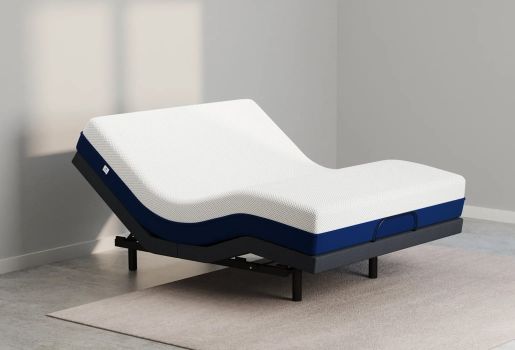
- Adjust to your favorite angle for sleep
- Drift off in the zero-gravity position
- Save your favorite sleeping positions for later
- Pair our frame with the mattress of your choice
- Enjoy a 30% discount
![Reviews - Average of 4.7 stars]()
15,000+ Reviews
Average of 4.7 stars1Sleep Awards
WinnerBest Mattress
for Back PainBest Mattress to Buy
OnlineMasterpieces of Midnight Melatonin Replenishment
Enjoy cooling comfort and dynamic support
We combine Bio-Pur® and HIVE® technology so our king size bed stays cool and supports a healthy posture no matter your preferred sleeping position. Our plant-based foam is engineered to bounce back in seconds, so you'll never feel "stuck." Plus, it's low in VOCs, minimizing off-gassing odors.

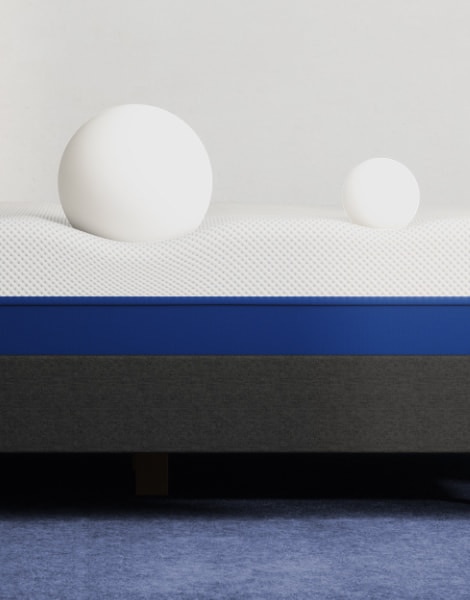
Your best night's sleep awaits.
We engineer our mattresses to offer superior comfort and support. Side, back, and stomach sleepers alike can wake up rested and energized thanks to innovative Bio-Pur®, a breathable, soft layer made to cushion all your pressure points. The other layers work together to give you the healthiest sleep possible.
Upgrade your night's sleep today.
Shop our mattressesWho are king size mattresses best for?
We recommend king size mattresses for couples since they offer 38 inches of personal space on either side of the bed—perfect for two sleepers.
Extra wiggle room
King size mattresses are 76 inches wide, offering plenty of room to sprawl out without impeding your partner's space.
Ideal for families
If you share your mattress with a partner or your children, a king size can comfortably accommodate more than one sleeper.
Fits most master bedrooms
Most master bedrooms are large enough to fit a king size mattress, so you don't have to worry about space.
How much do king mattresses usually cost?
We all approach mattress shopping with an idea of what we'd like to spend. Before you shop, it helps to have reasonable expectations and understand how much quality your dollar can (and cannot) buy.
First, let's get this out of the way: you don't have to spend thousands of dollars on a high-quality mattress. Beds that cost upwards of $3,000 may be marketed as the peak of luxury, but that's typically all the high price tag really signifies.
With that said, there are some added mattress features you may need to raise the price of a basic model. For instance, if you're looking for a bed with cooling technologies or added lower back support, these added materials tend to bump up the cost a little bit.

Common mattress features increasing mattress cost
- Cooling technologies, such as gel foam, copper-infused foam, or plant-based foam
- Proprietary foams or technologies (materials made exclusively by and for the brand)
- Edge support (in the form of poly foam or other materials reinforcing the edges)
- A quilted Euro top layer (Euro pillow tops are more expensive than plush pillow top mattresses because they contain higher quality materials)
- A longer than average warranty (average is 10 years)
- Thicker comfort foams (in general, softer beds use more layers, and are therefore more expensive)
- Eco-friendly materials, such as organic cotton, latex, or plant-based foams
| Mattress Type | Low End Price | High End Price |
|---|---|---|
| Foam | $250 | $4,000 |
| Innerspring | $300 | $3,000 |
| Hybrid | $250 | $4,000 |
| Latex | $300 | $4,000 |
How big is a King size mattress?
A king size mattress is 80 inches long and 76 inches wide.
Twin
38" x 75"
Twin XL
38" x 80"
Full
53" x 75"
Queen
60" x 80"
King
76" x 80"
Cal King
72" x 84"
Split King
38" x 80"(x2)
Which mattress size is best for me?
Twin - 38" x 75"
Kid's room, studio apartments
Twin XL - 38" x 80"
College dorm, studio apartments
Full - 53" x 75"
Kid's room, studio apartments
Queen - 60" x 80"
Master bedrooms, guest rooms
King - 76" x 80"
Extra large master bedrooms
Cal King - 72" x 84"
Extra large master bedrooms (10' x 12')
Split King - 38" x 80" (x2)
Master bedrooms, adjustable beds

Are online mattresses high-quality?
Bed in a box mattresses are everywhere, but the concept of buying a mattress from your laptop or smartphone and getting it shipped to your door is still fairly new. Foam mattresses, in particular, lend themselves well to online mattress brands because they can be easily compressed down and rolled up to fit in a compact box. What's more, online mattress brands cut out the middleman, overhead costs, and inflated prices associated with brick and mortar retailers, giving customers the opportunity to snag a high-quality bed for a good price.
But are beds in a box really high-quality? Let's compare our Amerisleep mattress models to a typical foam bed found at a mattress store.

Amerisleep King
Average King from a showroom
- Free delivery to the lower 48 states
- Delivery usually not free
- Free returns within the sleep trial
- Free returns only if mattress is in its original condition
- 100-night, risk-free sleep trial
- No sleep trial
- 20-year warranty (10-year full replacement)
- 10-year full replacement
- Made with plant-based materials
- Foams made with petrochemicals
- Made in the USA*
- Origins not always known
- Manufactured with low VOCs
- Off-gassing odors
*Made in the USA of U.S. and imported components. Covers sewn in Canada.
What is the Amerisleep difference?
Traditional innerspring mattresses are still popular today. Chances are, you've slept on an innerspring before—they're still frequently used in hotel rooms and college dorms because they're relatively inexpensive.
Most innersprings are made with steel coils in the core, increasing airflow through the bed, and the top comfort layer is a quilted Euro or pillow top made of poly-foam, memory foam, or latex foam.
Despite their popularity, coil mattresses aren't long-lasting, having an average lifespan of five years. In fact, the customer satisfaction level for innersprings is the lowest of any mattress type.
Amerisleep vs. Other Mattress Types
| Benefits |
Amerisleep Mattress |
Innersring Mattress |
Traditional Memory Foam Mattress |
Hybrid Mattress |
Latex Mattress |
|---|---|---|---|---|---|
| Responsiveness | Bounces back in seconds | Bounces back very quickly | Slow to respond, results in "stuck" feeling | Responsive but prone to sagging | Very responsive |
| Pressure-Relief | Exceptional pressure relief | Little to no pressure relief | Good pressure relief | Some pressure relief | Good pressure relief |
| Cooling | More breathable than traditional memory foam | Cooling thanks to the coils in the base | Traps heat | Cooling thanks to the coils in the base | Cooling as long as top layers are aerated |
| Foam quality | Partially plant-based Bio-Pur® material | Usually made with poly-foam pillow tops | Foam usually made with petrochemicals | Not always consistent, depends on the type of foam used in the top layers | Depends on the type of latex used; synthetic latex breaks down faster than all-natural |
Let's look at our best-selling mattress, the AS3
We carefully craft each layer of foam to offer superior comfort and dynamic support to help you get your best night's sleep.
- Lightweight, soft cover allows hot air to escape out of the bed, preventing night sweats
- 3 inches of Bio-Pur® contours to your specific shape and adapts to your every sleeping position
- The 2-inch Affinity layer with HIVE® technology supports sensitive pressure points like the lower back, hip, and shoulders
- 7 inches of durable Bio-Core® prevents sagging, extending the AS3's lifespan beyond the typical 10 years
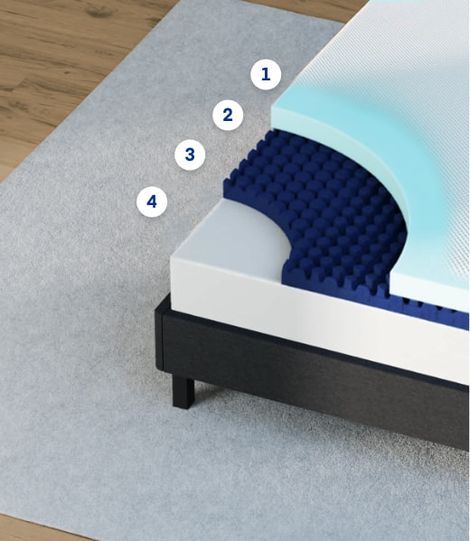
Frequently Asked Questions
Where can I put my new king size bed?
When it comes to mattress foundations, you've got plenty of choices. Memory foam mattresses can be used with platform beds, slatted foundations, or an adjustable base. Typically we would not recommend using any memory foam mattress with a box spring because they can cause the foam to sag.
If you do use your king size memory foam mattress with a slatted base, make sure the slats are no more than 3 inches apart. The type of bed frame you pair with your mattress can affect its lifespan, so make sure you read the manufacturer's foundation guidelines— otherwise, you risk voiding your warranty.
No matter which foundation you choose, make sure it meets the requirements set out by the warranty. If you select a bed frame that is incompatible with your mattress, you run the risk of voiding your warranty protection.
An adjustable bed base is a great option if you're looking for extra customization. Adjustable beds allow you to elevate your legs and head, which improves circulation, minimizes snoring and sleep apnea symptoms, and takes pressure off your back. Not only are adjustable bases great for healthy sleep, but they're convenient too— you can maintain a healthy posture while you read, watch TV, or relax in bed.
Some companies offer adjustable mattress sets so you can get a new mattress and an adjustable frame at a great price.
Thinking about an adjustable bed? Check our adjustable bed package here
What is the best king size mattress?
The "best" mattress should do at least three things
- Support your back
- Ease pressure points
- Last a long time
Obviously, because you spend one third of your life in bed, you want it to be comfortable! And because it's a big investment, you expect it to last. The best mattress for you depends on your mattress type, comfort level preferences, and budget. And, if you share your mattress with a partner, you have to consider their preferences too!
Before you choose a king size bed, consider the pros and cons of each mattress type.
| Mattress Type | Pros | Cons | Best For: |
|---|---|---|---|
| Memory Foam |
Pressure-relief Contouring Responsiveness Quiet Excellent motion Isolation Hypoallergenic | Sometimes traps heat Can result in "stuck" feeling | Side sleepers Combo sleepers Back sleepers Stomach sleepers |
| Innerspring | Responsiveness Cooling Edge support |
No pressure relief Motion transfer Bouncy but noisy Sags quickly Collect dust mites and allergens easily | Stomach sleepers Back sleepers |
| Hybrid | Responsive Cooling Some pressure relief Some motion isolation | Can be noisy Can sag quickly Can collect dust mites and allergens easily | Side sleepers Combo sleepers Back sleepers Stomach sleepers |
| Latex | Responsive Cooling Hypoallergenic Motion isolating | Heavy Expensive Firmer feel compared to memory foam Too responsive for some | Side sleepers Combo sleepers |
Memory Foam Mattreses
Memory foam isn't exactly new in the mattress world, but recent innovations have made it more and more popular. The most recent trend to boost memory foam's availability is the bed in a box revolution, which cuts out the middleman (brick and mortar stores) and ships mattresses directly to customers' doorsteps. Memory foam mattresses are easy to compress and ship in a box, so they go hand in hand with this new delivery format.
A basic memory foam mattress model has 2-3 layers of foam with some variation depending on the firmness (firmer mattresses have fewer layers, softer mattresses have more). A true memory foam mattress has memory foam in its comfort layers and then a firmer, stiffer foam as the bottom layer (usually poly foam).
Memory foam is dense and soft— two characteristics that lend themselves well to a silent, pressure-relieving sleeping surface. However, this same high-density foam is known to trap heat. Manufacturers of this popular foam infuse it with cooling gel, green tea, charcoal, graphite, or copper to dissipate some of the heat.
Amerisleep's memory foam, known as Bio-Pur®, is partially plant-based, making it more responsive and breathable than traditional memory foam.
Innerspring Mattresses
Innerspring mattresses are still the most common, widely available mattress type. They're bouncy thanks to their coil support cores, but they offer little by way of pressure relief because of their thin Euro or pillow tops (comparable to the comfort layer in a memory foam mattress).
Innersprings have one advantage over memory foam: they sleep cooler because air can easily move through the bottom coils. However, these same coils lead to sagging and deterioration after only a few years. This is probably one reason memory foam is starting to take over as the most popular type of mattress.
Hybrid Mattresses
Hybrid mattresses look and feel quite similar to innersprings, but there's a couple of major differences: first, hybrids contain more foam in their top comfort layers. In fact, a hybrid must have 2-3 inches of foam to even be classified as a “hybrid.” Second, hybrids are often made with individually-wrapped coils, also known as Marshall coils. Each steel coil is wrapped in soft fabric or foam to alleviate motion transfer and noise (two problems common to innersprings).
Latex Mattresses
Latex is popular because it feels similar to memory foam, but it's not always made with polyurethane like memory foam. For that reason, it appeals to eco-friendly consumers. Dunlop latex is harvested from the sap of a rubber tree, a renewable resource. Dunlop feels firmer than the other latex type, Talalay. Talalay latex also comes from rubber tree sap, but polyurethane fillers are added to give it a softer, bouncier feel.
Latex is not as easy to find as memory foam, nor is it available in a wide range of budget options. However, it's incredibly durable, so some prefer to invest more money in it because of its longevity.
Are there different size king beds?
Some basic mattress sizes are available in a few different iterations, like the Twin XL or the Olympic Queen. When it comes to king size beds, there are really only four variations: the standard king, split king, California king, and split California king.
| Standard King | California King | Split King | Split California King |
|---|---|---|---|
| 76 inches wide, 80 inches long | 72 inches wide, 84 inches long | Two mattresses each, 38 inches wide, 80 inches long | Two mattresses each, 36 inches wide, 42 inches long |
Many couples like using split mattresses with an adjustable base since that allows for the ultimate customization.
Do two twin beds make up a king?
No, two twin size beds are not the same size as a king. However, two twin XL mattresses are the same size as a regular king size bed. If you're looking for a mattress both you and your partner can adjust to your preferences, we recommend a split king mattress.
Does my weight affect the mattress feel?
Yes, your body type can change the way your mattress feels. Heavyweight sleepers tend to compress the memory foam layers more deeply, and thus prefer a very soft mattress (like the AS5, which has five layers), or a fairly firm mattress (like the AS2).
Lighter sleepers typically like soft beds since they don't compress the mattress much at all. Again, your weight and sleeping position both affect which firmness you prefer. No matter your body type, make sure your mattress uses a base that will not sag. A great mattress holds up under lots of pressure without losing support.
How do I know which mattress firmness is best?
When we hear “firmness” associated with a mattress, some of us shy away— we prefer a plush, cradling surface to sleep on. However, others need firm, steady support with very little give. Much of this firmness preference stems from the way we sleep, or our sleeping position.
To avoid confusion here, we suggest familiarizing yourself with the firmness scale. Many online mattress brands use it to classify each mattress model they sell. The scale is easy enough to decipher— it goes from 1-10, with 1 being plush and 10 being extra firm. Most mattresses do not fall at the extreme ends of this scale because if they did, they wouldn't be usable.
We classify each Amerisleep mattress by firmness and use this same scale to help customers differentiate between each model.
Firm (firmness scale: 8-9, AS1)
We classify each Amerisleep mattress by firmness and use this same scale to help customers differentiate between each model.
Medium-Firm (firmness scale: 6-8, AS2)
Medium-firm mattresses have been proven to alleviate back pain better than any other firmness. It used to be that most people assumed soft mattresses were best the best mattresses for back pain, but we now know that beds with too much soft cushioning can cause the back to sink down, putting pressure on it and leading to pain.
Medium (firmness scale: 5-7, AS3)
Medium mattresses tend to be the bestsellers for most mattress brands— maybe that's because they appeal to side sleepers, who make up the majority of the population. Medium mattresses have that perfect “Goldilocks” feel; they're not too soft or too firm. Medium beds are widely recommended for side and combination sleepers because they alleviate pressure points and provide enough spinal support.
Medium-Soft (firmness scale: 4-5, AS4)
Medium-soft mattresses are often constructed with the same amount of support and transitional foams as medium beds, but their comfort layers are thicker. You'll probably enjoy a medium-soft mattress if you're a dedicated side sleeper or you just like a bit more cushioning under your weary joints.
Soft (firmness scale 2-3, AS5)
Soft mattresses have the thickest comfort layers, but they should be reinforced with transitional or support layers to ensure they won't sag. Even the softest mattress can still keep the spine aligned as long as it has high-quality support foams in its middle and foundation layers.
How long should a good mattress last?
Your mattress’s lifespan depends on the quality of materials and how well you take care of it. With that said, some mattress types tend to last longer (or not as long) as others.
| Mattress Type | Average Lifespan |
|---|---|
| Amerisleep Mattresses | 15-20 years* |
| Traditional Memory Foam | 7-10 years |
| Innerspring | 5 years |
| Hybrid | 6-7 years |
We recommend using a mattress protector to ensure your mattress lasts as long as it’s supposed to and is protected from stains or spills, which usually void the warranty.
What should I look for in a mattress warranty?
Your mattress should come with a warranty; in the mattress industry, a 10-year warranty is standard. Almost all mattress warranties come with the same provisions, with some variation based on the brand and mattress type. In general, your mattress warranty should cover the following manufacturing defects:
- Sags below a certain depth (usually 1.5 inches or more)
- Bunched or torn foam
- Burst or bent coils
- Broken zippers
- Torn covers
Is memory foam safe?
Memory foam is made with polyurethane, a petroleum byproduct that creates a plush mattress. The EPA has declared memory foam to be safe, but some notice an off-gassing smell when they open their new memory foam beds. If you do experience this, open your windows and air out the bed for a day or two. The smell should dissolve within a few days.
What if my king mattress is too soft or too firm?
You can adjust your mattress firmness using a topper. While they are a temporary solution, they do work nicely to change the feel of a bed if you need a little something extra but don’t want to go out and buy a new mattress already.
Read mattress reviews and customer feedback to ensure the mattress you choose will complement your firmness preferences; that way, you won’t need to invest in a topper later on.
How long should sleep trials last?
A 30-90 night sleep trial is typical for most online mattress brands. The trial should last at least 30 days so you can adjust to the mattress and a healthier sleeping position. Sometimes our bodies get so used to sleeping a certain way on an unsupportive mattress, we hardly notice the mattress is causing us pain! Check to see if the mattress you’re considering comes with a generous sleep trial and an easy way to return the mattress if it ends up not working out.
Alternatives to King Mattresses
Queen
Best mattress for couples
A Queen is perfect for couples with limited room space or single sleepers who prefer the extra room to get comfortable.Cal King
Extra large master bedrooms (10' x 12')
The California Kings provide an additional 4 inches in length, but are 4 inches thinner as well. They work well for extra large master bedrooms.Split King
Master bedrooms, adjustable beds
Split King beds enable each side of the mattress to raise and lower their head and feet independently.
